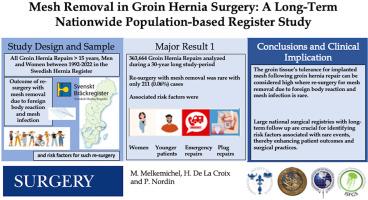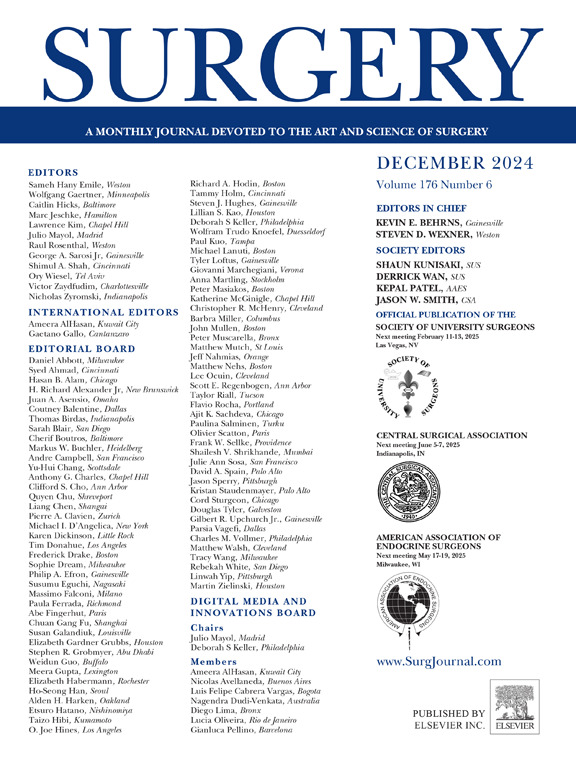腹股沟疝手术中的补片去除:一项长期的全国人口登记研究。
IF 2.7
2区 医学
Q1 SURGERY
引用次数: 0
摘要
背景:目前,腹股沟疝修补术是西方国家的金标准手术。然而,异物反应和补片感染是令人担忧的并发症。本研究旨在探讨腹股沟疝修补术后因异物反应和补片感染而取下补片的发生率及危险因素。方法:这是一项以全国人口为基础的观察性登记研究,使用瑞典疝登记处前瞻性收集的数据。所有在1992年至2022年间登记的15岁或以上的腹股沟疝修补患者都符合条件。主要结果是再手术取网的发生率。次要结局是再次手术取网的危险因素。结果:在这30年的研究期间,363,664例腹股沟疝修补中,211例(0.06%)再次手术并移除补片。女性腹股沟疝修补比例在补片组(15.2%)高于非补片组(7.9%)。经校正的多变量Cox回归分析显示,再次手术取网的风险比在女性(2.80,可信区间:1.70-4.63)、急诊(3.43,可信区间:1.94-6.03)、开放式前路补片(2.76,可信区间:1.61-4.72)和前后路联合补片(主要是补片塞)(3.98,可信区间:(1.84-8.57)腹股沟疝修补,对于总中位数为63岁以下的患者(2.61,可信区间:1.78-3.81)。结论:腹股沟疝修补术后腹股沟组织对植入补片的耐受性较高,因异物反应和补片感染而再次手术取网的情况较少见。女性、年轻患者、紧急修复和网塞是此类再手术最明显的相关危险因素。本文章由计算机程序翻译,如有差异,请以英文原文为准。

Mesh removal in groin hernia surgery: A long-term nationwide population-based register study
Background
Nowadays, groin hernia repair with mesh is a gold standard procedure in western countries. Yet, foreign body reaction and mesh infection are feared complications. This study aimed to investigate the prevalence and risk factors for mesh removal due to foreign body reaction and mesh infection after groin hernia repair.
Method
This is an observational nationwide population-based register study with the use of prospectively collected data from the Swedish Hernia Register. All patients 15 years or older with a groin hernia repair registered between 1992 and 2022 were eligible. The primary outcome was the prevalence of re-surgery with mesh removal. The secondary outcome was risk factors for re-surgery with mesh removal.
Results
Of 363,664 groin hernia repairs during this 30-year-long study period, 211 (0.06%) had a re-surgery with mesh removal. The proportion of female groin hernia repairs was higher in the mesh removal group (15.2%) compared with the nonmesh removal group (7.9%). The adjusted multivariable Cox regression analysis for the risk of re-surgery with mesh removal demonstrated significantly increased hazard ratios for female (2.80, confidence interval: 1.70–4.63), emergency (3.43, confidence interval: 1.94–6.03), open anterior mesh (2.76, confidence interval: 1.61–4.72), and combined anterior/posterior mesh (predominately mesh plugs) (3.98, confidence interval: 1.84–8.57) groin hernia repairs, and for patients below the total median of 63 years (2.61, confidence interval: 1.78–3.81).
Conclusion
The groin tissue's tolerance for an implanted mesh after a groin hernia repair can be considered high where re-surgery for mesh removal due to foreign body reaction and mesh infection is rare. Female sex, younger patients, emergency repairs, and mesh plugs were most evident associated risk factors for such re-surgery.
求助全文
通过发布文献求助,成功后即可免费获取论文全文。
去求助
来源期刊

Surgery
医学-外科
CiteScore
5.40
自引率
5.30%
发文量
687
审稿时长
64 days
期刊介绍:
For 66 years, Surgery has published practical, authoritative information about procedures, clinical advances, and major trends shaping general surgery. Each issue features original scientific contributions and clinical reports. Peer-reviewed articles cover topics in oncology, trauma, gastrointestinal, vascular, and transplantation surgery. The journal also publishes papers from the meetings of its sponsoring societies, the Society of University Surgeons, the Central Surgical Association, and the American Association of Endocrine Surgeons.
 求助内容:
求助内容: 应助结果提醒方式:
应助结果提醒方式:


